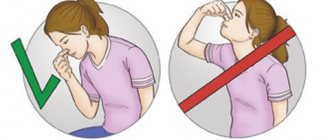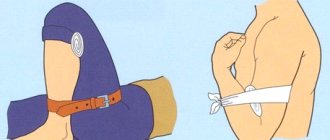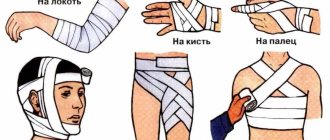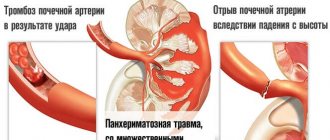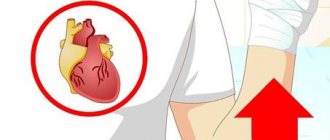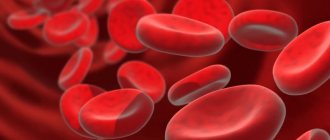Table of contents
- Hemostatic tourniquet, fabric-elastic
- Esmarch's tourniquet
- Harness “Alpha”
- Apollo silicone harness
- Hemostatic tourniquet CAT (USA)
- Hemostatic tourniquet (tourniquet) Medplant (Russia)
- Tourniquet tourniquet Rapid
Not the most popular remedy in the first aid kit - a hemostatic tourniquet - can save a person’s life. When large arteries are damaged, minutes count. Whether the victim survives or not depends on how quickly and effectively the tourniquet is applied.
Can a tourniquet, for example, from a standard car first aid kit, stop bleeding? The answer is clear: no! It’s probably not even worth wasting time on trying to stop bleeding with this dubious device: it is not able to stop arterial bleeding.
Meanwhile, the most dangerous type of bleeding is arterial. Application of a tourniquet as first aid is indicated only for damage to large arteries. For venous bleeding, a pressure bandage is required. It is not difficult to distinguish arterial bleeding - blood flows out very quickly, in a pulsating fountain. It is useless to “guess” the shades of blood; in a critical situation, it is impossible for non-professionals to do this.
So, we have a victim with arterial bleeding. The first thing we must do is take a first aid kit, place it next to the victim, and quickly put on rubber gloves. In a critical situation, it is important to gain time to figure out what to do next. But with arterial bleeding, blood loss increases catastrophically quickly. Therefore, you need to clamp the damaged artery, temporarily stopping the bleeding with the pressure of your limb (it is possible, and sometimes necessary, even with your knee).
Next, you need to find a tourniquet somewhere. This is where the fun begins. It is ideal when a reliable tourniquet is in the first aid kit, and there are also people around who can carry out the actions that you indicate to them (call an ambulance, apply a tourniquet, find paper to record the time of application, etc.). But it may happen that there is no suitable tourniquet and you will have to invent one from a belt, elastic bandage, cloth, etc. It must be said that such attempts to stop bleeding, especially if you have no practice behind your back, are ineffective: you apply a tourniquet from improvised means, the skin turns blue, which indicates incorrect application, and the bleeding does not stop. From this it follows that everyone should take care in advance about having a good tourniquet in their first aid kit. But how to choose a really good tourniquet? What kind of harnesses does the market offer us?
Esmarch's tourniquet
Photo: mediform.su
Esmarch's rubber tourniquet was developed before the October Revolution.
An effective and budget option. Apply strictly to fabric (bandage), and never to bare skin! It is necessary to take into account that it is regularly necessary to check its suitability, since rubber loses its elastic properties during long-term and improper storage, temperature changes and other physical factors. Esmarch tourniquets tend to break at the most inopportune moment, so if you choose this tourniquet for your first aid kit, you need to purchase at least two.
State Description
Arterial bleeding is a rapid release of blood from a blood artery caused by its damage. Blood flows out of the wound in a pulsating stream in time with the work of the heart muscle.
When small arteries rupture, a person has only 30-60 minutes to stop the bleeding. If large arteries (carotid, femoral) are damaged, loss of consciousness and death can occur within a few minutes.
Arterial bleeding can be external (blood is released outside the body) or internal (blood is released into the abdominal cavity, lungs or muscles).
The consequences of blood loss largely depend on how effectively the compensation mechanisms work:
- Vascular reflex. It comes into effect on the first day after the injury. It consists in the release of adrenaline, which, acting on the vessels, leads to the inclusion of blood deposited in the veins into the general bloodstream.
- Hydremic. Characterized by replenishment of blood flow with intercellular fluid.
- Bone marrow. The production of red blood cells and other blood cells in the spinal cord is activated.
Arterial bleeding is especially dangerous for children and the elderly, since their protective compensation mechanisms work less well.
Distinctive signs of arterial bleeding
In order for first aid for arterial bleeding to be timely and as effective as possible, you should be able to distinguish it from venous bleeding.
Venous bleeding is characterized by the flow of blood in a slow stream that is dark in color. During arterial bleeding, blood flows out in a scarlet, pulsating stream.
- How to apply a tourniquet for arterial and venous bleeding
It is quite simple to stop the flow of blood from a vein by applying a pressure bandage and ensuring the damaged area is in an elevated position. When an artery ruptures, it is very difficult to stop the bleeding. Effective ways to save a person in this case would be finger pressure (temporary measure), application of a tourniquet or tight tamponade.
Harness “Alpha”
Photo: orion-spec.ru
The developers position it as a super-strong harness that will never fail or break. Its structure allows you to conveniently and effectively stop bleeding; the device can be applied directly to bare skin. First aid instructors are not so optimistic about “Alpha”, since he is eager even in class, let alone in a critical situation. In addition, its length is not always enough. This tourniquet is stronger than the Esmarch tourniquet, more convenient, but still has its drawbacks.
General principles of first aid
If arterial bleeding occurs, first aid should be provided immediately.
The following actions should be taken:
- lift the injured part of the body;
- press the wound with your fingers slightly above the rupture site (a short-term measure, used to reduce blood loss before applying a tourniquet);
- apply a tourniquet, a pressure bandage, or pack the damaged area;
- call an ambulance or independently deliver the victim to a medical facility.
The method of stopping bleeding depends on its location. If the thigh, forearm and arm are injured, it is necessary to apply a tourniquet, after first pressing the artery to the bony protrusion above the damaged area. Pressing is done like this:
- in case of a thigh injury: it is necessary to press with your fist on the upper third of the thigh in the area of the inguinal ligament;
- if the forearm is injured: place several rolls of medical bandage in the elbow bend and squeeze the arm tightly in the joint;
- if an artery in the arm is ruptured: stick your fist into the armpit (you can use a bottle) and press your arm to your body.
Damage to the cervical arteries
There are two large arteries in the human neck: the carotid and the subclavian. Bleeding in this location is stopped by applying a tight wound tamponade.
Latest postsIs it possible to give a mirror: how to protect yourself from bad omensIt became known about the influence of cell phone towers on human healthIs it possible to eat bananas bought in Russia?
The procedure is carried out using tweezers: a sterile bandage or napkins are tightly placed into the wound cavity, after which the damaged area is tightly bandaged.
In the absence of tweezers and a sterile bandage, it is advisable to use a clean handkerchief, previously soaked in alcohol or other strong alcohol. Fingers should also be disinfected with alcohol or hydrogen peroxide.
Regardless of the location of the wound, the patient should be immediately taken to the hospital (or call an ambulance). The effectiveness of pre-medical measures to save a person will depend on the speed of providing professional medical care.
General rules of use
There are specific rules for applying a tourniquet to certain areas of the body. The following is general information that can be used during first aid.
A tourniquet should only be used if you were unable to eliminate blood loss by other methods. Ideally, any contact with blood/other body fluids should be done with gloves. Absolutely all mucous membranes (eyes/mouth/damaged areas of the body) must be protected from infectious infection, but in critical situations, medical supplies are rarely at hand. Instead, you can use a plastic bag, film, paper file, or anything else that will help reduce the risk of infection.
Before applying a tourniquet, try to bend the victim's limb as much as possible to press against the artery or apply direct pressure to the wound. The list of actions depends on the intensity of blood loss and its location. This way you can partially stop the outflow of fluid and successfully apply a tourniquet. To avoid dead or pinched skin, be sure to cover the affected area with clothing, a towel, gauze, bandage or any other clean cloth.
A tourniquet is applied above the bleeding site (for example, on the thigh if the foot is injured). The rule does not apply only in case of traumatic amputation of a limb. In this case, the tourniquet is placed as close as possible to the damaged area. Tourniquet of the forearm or lower leg is considered ineffective. The vessels in these parts of the body lie too deep, so even strong tension of the tourniquet will not help stop blood loss.
The time the tourniquet is on the limb is limited. In the warm season it should not exceed 60 minutes, in the cold season - 30, but doctors advise limiting it to 30-40 minutes, regardless of the season. If the ambulance does not arrive in time during this time, it is permissible to loosen the tourniquet for 10 minutes to restore blood flow. During these 10 minutes, you should press the damaged artery with your fingers, and then re-install the tourniquet.
If possible, attach a note to the tourniquet, which will record the time and date of its application, accurate to the minute. A similar inscription can be left on the forehead or other visible areas of the body. This information can save the victim's life and help doctors determine next steps.
Every victim needs pain relief. Installation and loosening of the tourniquet brings unbearable pain, which is aggravated by the trauma received during the incident. When calling an ambulance, check the waiting time for the team and agree on the issue of pain relief. Try to create the most comfortable conditions for the victim before the doctors arrive. Cover him with clothes or a blanket (even in the warm season), help him take a comfortable position and calm the person if he is conscious.
Common mistakes when using a tourniquet
Doctors identify several main mistakes during first aid:
- application of a tourniquet without appropriate indications;
- fixation of the node on bare skin, which leads to pinching and tissue necrosis;
- too weak fixation, which does not affect the intensity of blood loss;
- too strong fixation, which leads to tissue injury;
- improper application of a tourniquet, in which only the vein is compressed, which leads to increased blood loss, swelling, redness and bluishness of the skin;
- incorrectly selected area of the body for applying a tourniquet;
- lack of information about the time of first aid;
- covering the tourniquet with a bandage.
How to determine that the harness is installed correctly? The bleeding will stop, the skin will turn pale, and the pulsation of the peripherally located arteries of the limb will disappear.
Take the victim to the nearest hospital
Call an ambulance at 103 or bring the person yourself. Do this as quickly as possible Prehospital Tourniquet Use in Operation Iraqi Freedom: Effect on Hemorrhage Control and Outcomes. If blood does not flow to the arm or leg, the tissue will die.
Previously, it was believed that a tourniquet could be applied for no more than 1 hour in winter and 2 hours in summer. But research from Prehospital Tourniquet Use in Operation Iraqi Freedom: Effect on Hemorrhage Control and Outcomes shows that this period can be extended. There are cases in the military where a limb was saved after 6 hours of applying a tourniquet.
Distinctive signs of arterial bleeding
The classification of bleeding implies its division into three main types:
- arterial,
- venous,
- capillary.
With extensive traumatic injuries, mixed bleeding, for example, venous and arterial, can be observed. In addition, any bleeding, relative to where the blood flows, is divided into internal (in the body cavity) and external (into the external environment). First aid for internal bleeding, as well as its diagnosis itself, is carried out exclusively by medical staff. External bleeding is easier to diagnose and can be treated by anyone.
Arterial bleeding occurs due to damage to the arterial trunks - the vessels that carry oxygenated blood from the cavities of the heart to all tissues of the body. Venous-type bleeding develops when the integrity of the veins that collect blood saturated with carbon dioxide and carry it to the heart is disrupted. Capillary bleeding occurs due to traumatization of capillaries - small vessels that are directly involved in tissue gas exchange.
External differences in types of bleeding
With arterial bleeding, the color of the flowing blood is bright red or scarlet, in contrast to venous bleeding, in which the blood is dark red and comes out slowly. In the case of arterial damage, blood is released rapidly, in a gushing stream. At the same time, the blood stream pulsates, each portion of it comes out synchronously with the pulse and heartbeat. This is due to high pressure in the arterial vessels that come directly from the heart.
In case of arterial bleeding, if help is not provided in time, the phenomena of hemorrhagic shock quickly increase - a pathological condition due to significant blood loss. It has the following symptoms:
- drop in blood pressure;
- increased heart rate;
- pallor and marbling of the skin;
- cyanosis of the extremities;
- respiratory disorders;
- decreased diuresis;
- severe weakness;
- dizziness;
- cold extremities;
- loss of consciousness.
Attention! The faster a person loses blood, the more pronounced the symptoms of shock are, since the body does not have time to compensate for the blood loss.
general characteristics
A tourniquet is a device to stop bleeding. It is used to compress the soft tissues of the affected limbs in order to temporarily stop blood loss and have time to deliver the victim to a doctor. A bandage is necessary to stop extensive bleeding from the great vessels. In other cases, compression and a tight bandage are sufficient.
Ideally, the tourniquet is applied for a maximum of 30-40 minutes, regardless of the person’s condition, time of year, environmental conditions and other factors. Why? In essence, the limb is “cut off” from the general blood flow, which can be fraught with tissue necrosis, infringement of the organ’s nerve trunks, and even death. Oxygen starvation develops in a separate part of the body. The tissue stops receiving vital components such as blood, oxygen and nutrients. The result is limb death and the need for amputation.
Content:
- general characteristics
- Indications/contraindications for use
- Types of tourniquets
- General rules of use
- Possible complications
What to do if you can’t get a tourniquet in an emergency? Make a makeshift bleeding stop using fabric tape, rope, your own belt, and anything else you can get your hands on. They will help stop blood loss and fix the affected area no worse than medical instruments. The main difference is the comfort of the first aider. Most rubber bands have holes made for a retainer or are self-tightening. This simplifies the provision of emergency first aid, but even an ordinary piece of fabric, hastily torn from clothing, will perform an identical function (if used correctly).
For how long can a hemostatic tourniquet be applied?
The Esmarch tourniquet is applied for a strictly defined time, after which it must be removed. If the victim is injured while on the street and is not indoors awaiting qualified medical care, the time of year matters:
- winter - half an hour (and be sure to cover the limb with something warm);
- summer - 1 hour.
Experts recommend using a note indicating the time of the previous application and placing it under one of the turns of the tourniquet. As time passes, the hemostatic tourniquet for arterial bleeding is removed and tied again, but slightly above the original site. It’s good if two people perform the procedure - one covers the artery, and the second wraps the tourniquet. The total application time should not be more than 2 hours, otherwise there is a high risk of tissue necrosis.
